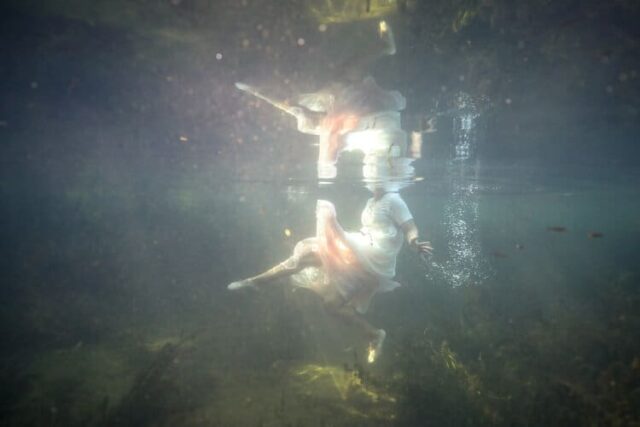Allison Janae Hamilton (American, b. 1984)
Floridawater II, 2019
24 x 36 in
Archival pigment print, AP 1/2
Gallery Purchase from the Dr. Joan Huntley Art Acquisition Fund
Floridawater II captures a murky, underwater scene in Florida’s Wacissa River. A woman — Hamilton herself — occupies the center of the photograph, draped in a white dress that the sunlight beams down upon into the water. In the pockets of fabric where the sun bleeds through, her dress appears pinky-orange in comparison to the cool tones surrounding her, like she is a source of light. The flowing white dress and its pseudo-supernatural light emission creates a haunting, ghostlike appearance, reminiscent of various legends of women in white: apparitions associated with tragedy. Alternatively, the figure could be a symbol of rebirth, submerged in water wearing white like a baptism.
Hamilton points her ballet flat-clad feet and stretches her arms out beside her, keeping her balance like a ballerina (or trying to stay afloat and alive). Her limbs breach the inky darkness that surrounds her. Hamilton’s head remains above the water, shrouded by a reflection of her body in the blue-green haze. This swampy aquamarine water is indicative of Florida, so it carries the contradiction of both a sense of familiarity and the mystery of the unknown. Various underwater plants reach toward the surface by Hamilton’s feet: the kind of plants that tickle and scare you when you are in water that shallow. In that moment, they could be anything.
The Floridawater photographs explore a series of connected rivers in North Florida often referred to as the slave canal. Dug in the 1850s to bring cotton from Georgia through the Florida panhandle, the canal was already defunct by the time it was complete, due to the development of railroad transport. Hamilton tells the stories of the South: its history, its mythology, and its future.
Hamilton works in sculpture, installation, photography, and video. She was born in Kentucky, raised in Florida, and her maternal family’s farm and homestead resides in the rural flatlands of western Tennessee. Her relationship with these locations forms the cornerstone of her artwork, particularly her interest in landscape and environmental catastrophe.
– Isabel Smith ’24

